ASUS Transformer Book TX300CA Review
ASUS continues to experiment and produce innovative devices. Such interesting devices as Transformer Pad or TAICHI have proven themselves, possessing unique features that competitors do not have. The new Windows 8 operating system with a finger-oriented interface gave a powerful impetus to the release of computers in a new form factor. One of these devices is the hero of our today's review, the Transformer Book, a thin tablet running on a full-fledged Windows 8, which has a Core i5 processor inside. Included is a dock that turns the tablet into a laptop. The dock also contains additional external interfaces, a battery and a 500 GB hard disk (!).
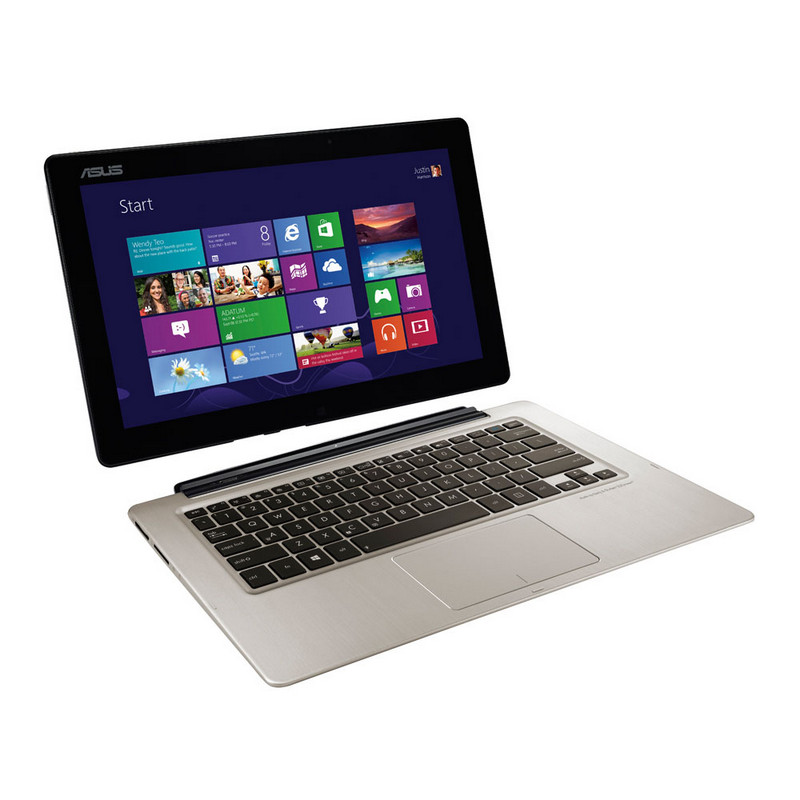
')

Processor: Intel Core i7 3517U or Intel Core i5 3317U
Operating system: Windows 8
RAM: 4 GB, DDR3 1600 MHz SD RAM, built-in
Display: 13.3 "16: 9 IPSFHD (1920x1080)
Graphics: Embedded, Intel® HD Graphics 4000
Data storage: 320 GB HDD with 128 GB SSD or 500 GB HDD with 128 GB SSD
Camera: HD WebCam
Network: 802.11 b / g / n, Bluetooth 4.0
Tablet interfaces: COMBO audio jack, micro HDMI, Docking Connector, micro SD
Dock Interfaces: 2xUSB 3.0, RJ45 Gigabit-LAN, Docking Connector, mini Display Port, 2-in-1 SD / MMC card reader (SDHC / SDXC)
Sound: 4 speakers, microphone, support for MaxxAudio
Battery: two-cell 5000 and 3120 mAh polymer batteries
Power supply: output - 19 V DC, 3.42A, 65W; input - 100-240 V AC, 50/60 Hz
Dimensions: Tablet: 213 x 340 x 4-11mm; Keyboard: 219 x 340 x 3-12.9mm
Weight: 1.9 kg with docking station

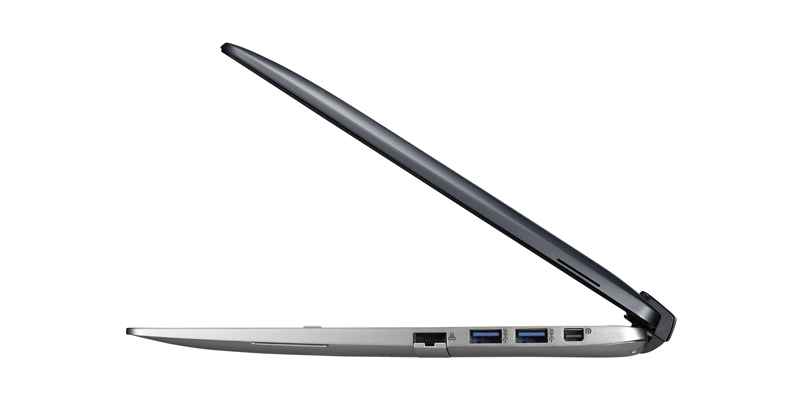
The appearance of the box is similar to that of other models of laptops from ASUS - a black elongated box of small length, the surface is matte, the Transformer Book is depicted at the top. Stickers, barcodes are missing - nothing more.
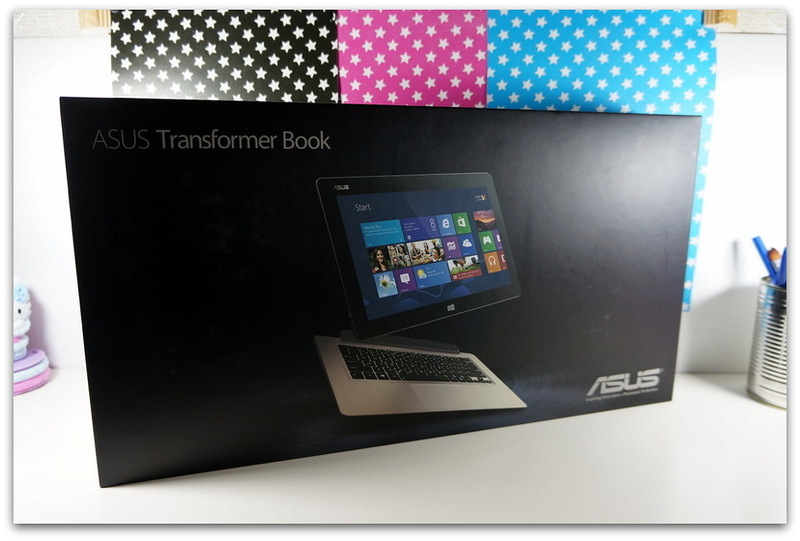
Opening the box, we see: the tablet, on the right - the charger. There is a sponge on the inner surface of the lid of the box to prevent scratches on the device, although initially the tablet itself and the dock are packed in film. Below there is a small notch for more convenient removal of the tablet.

Remove the dividing cardboard and see the bottom of the docking station, under it - an envelope with the documentation.

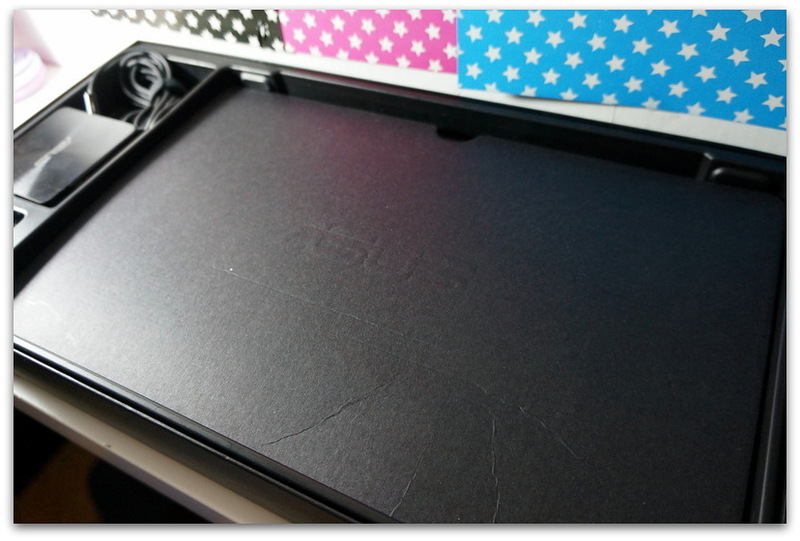
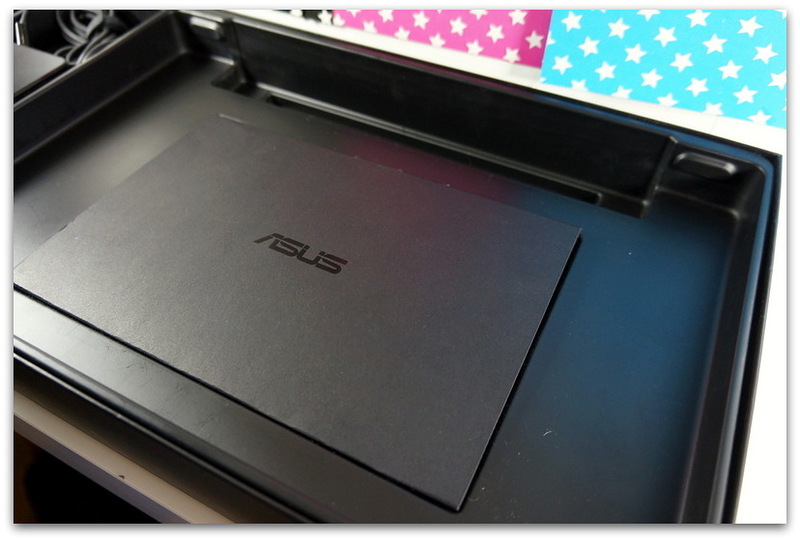
The charger is different in that it uses not a standard connector, which is inserted into the tablet, but a magnetic one. To connect it, it is enough to bring the connector to the connector on the case, no matter how it is turned. To disconnect the charger, just pull the wire. Everything is simple and quite comfortable. And now, if you accidentally pull the charging cord, the laptop will not fall off the table - just unhook the wire.
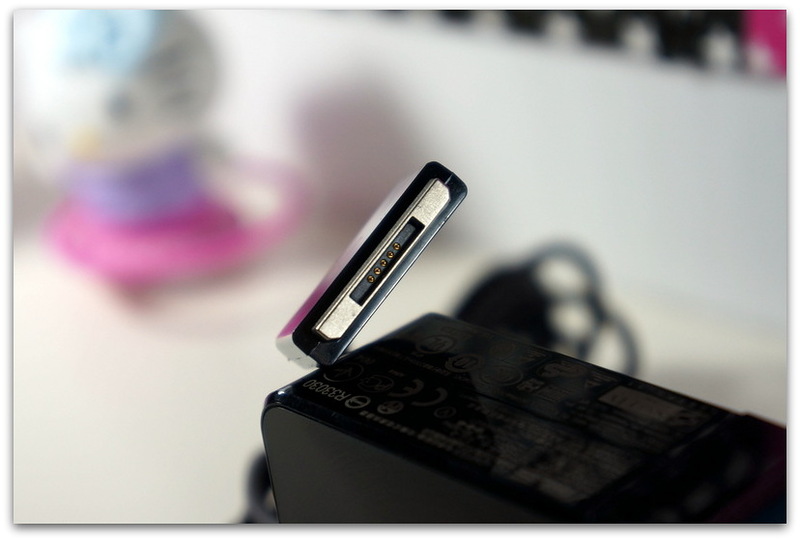
The charger itself is small, has a matte body, glossy sides. Charging design repeats the idea of concentric circles on ASUS laptops.
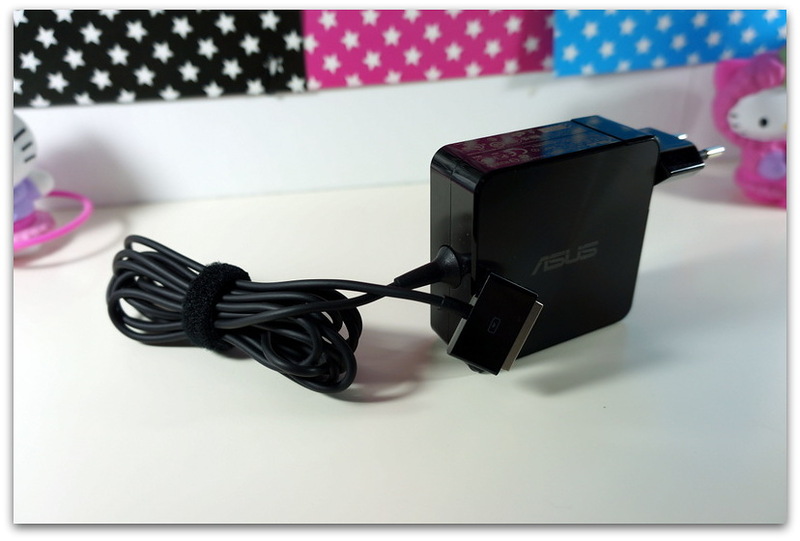
The front part is completely covered with glass. The widescreen screen, respectively, the device case turned out to be elongated and narrow. After 9-inch tablets, it is unusual to hold such a big device in your hands. When the tablet is inserted into the dock, it no longer seems so narrow - we have the usual modern laptop. The tablet itself weighs 975 g, its dimensions are 340x219 mm, and its thickness is only 11 mm. Moreover, when you hold it in your hands, it seems even thinner due to the fact that the thickness of the structure around the perimeter is reduced to 4 mm. The body is made of machined metal sheet and covered with a display, there are no bolts.
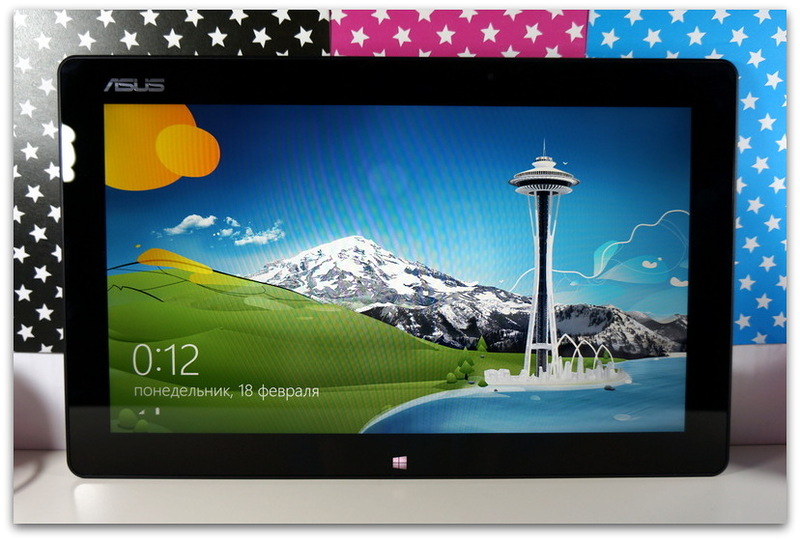
I checked all the glass around the perimeter - it does not press through, it does not creak. The design is strong and not bent. In the design of the back cover, ASUS follows the concept of ZENBOOK - concentric circles extending from the center.
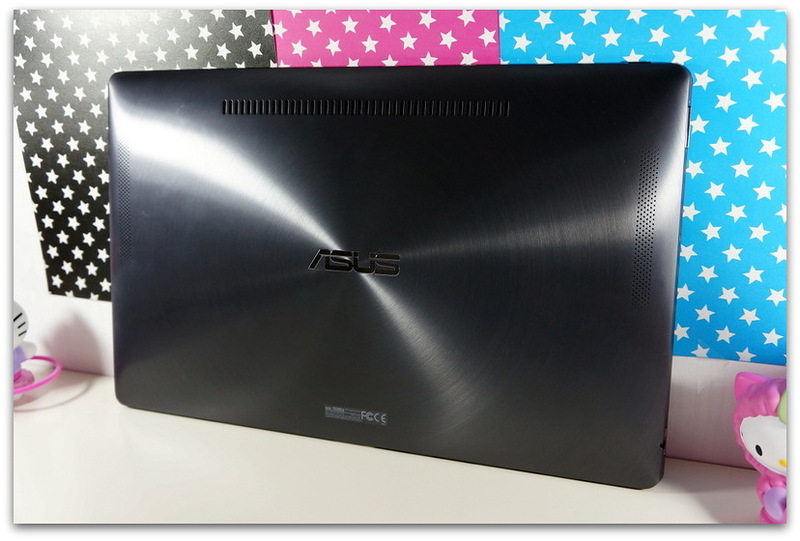
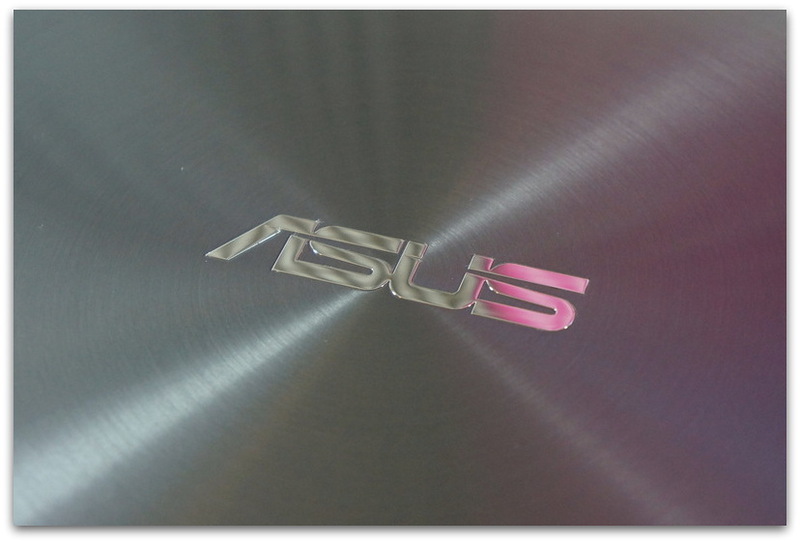
Upstairs there is a ventilation grille, with large speaker grilles on the sides.
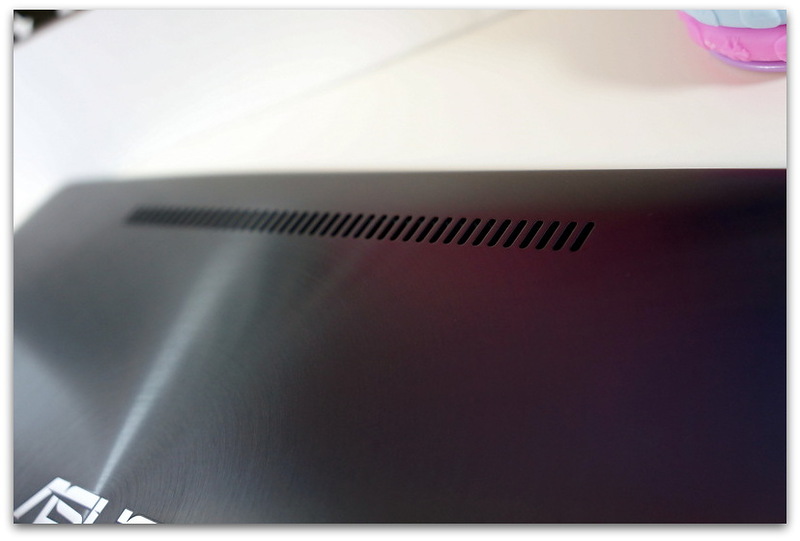
If you like it better when there is nothing extra on the device, you can remove the sticker.
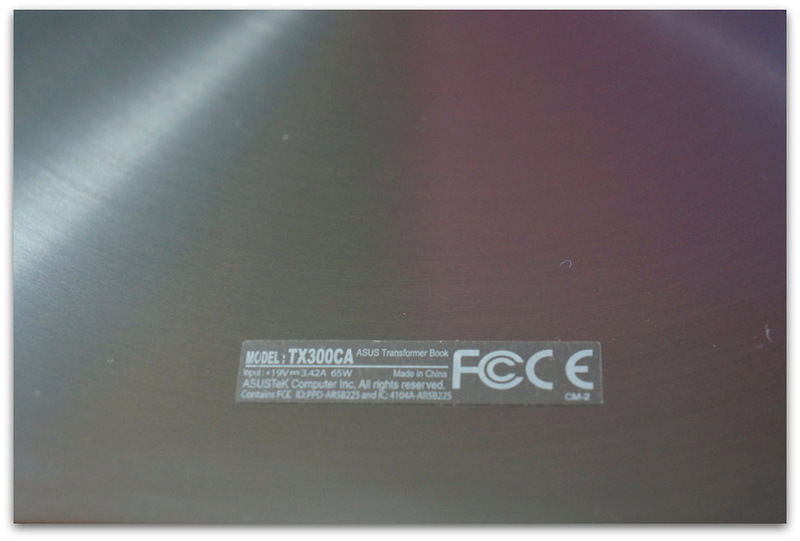
Now consider the docking station into which the tablet itself is inserted. The body is completely made of metal, the device is solid and durable.
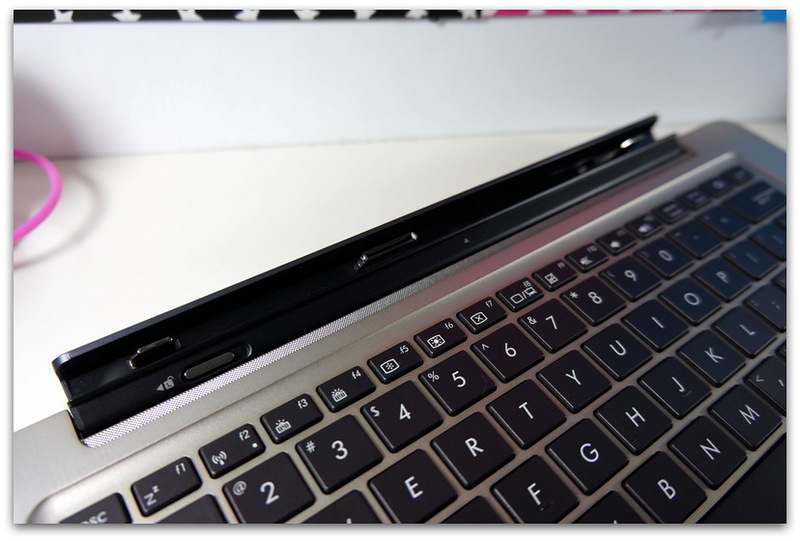
In the hands does not bend or creak, the construction is sound. The bottom is covered with a metal sheet, the joints fit exactly, the distance between the body and the bottom is minimal.
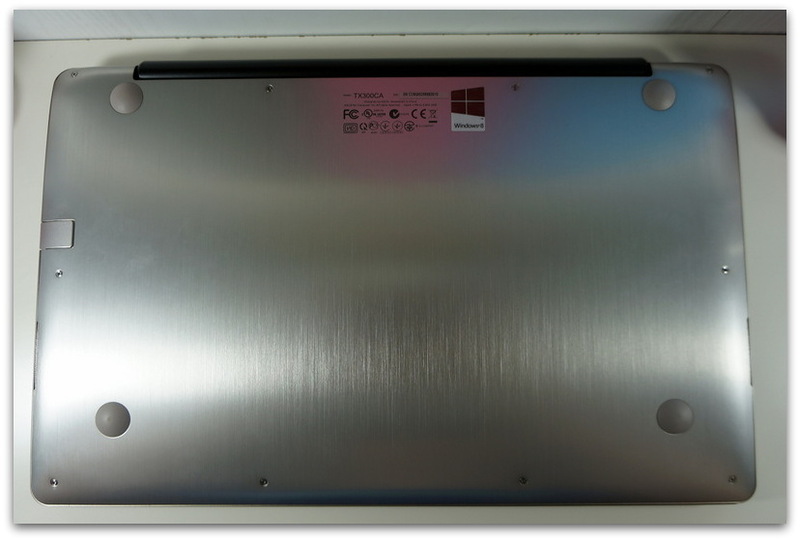

The docking station is made in a recognizable wedge-shaped design. The thickness of the dock is about 12 mm, it weighs 956 g. The hinge is made of thick plastic. The pins that hold the device, steel, latches are also metal. In order to avoid scratching the glass during installation in the dock, the fastening walls are covered with a cloth.

The process of installing the tablet in the docking station is quite simple: drop the device into the dock, we hear a click - it's done.
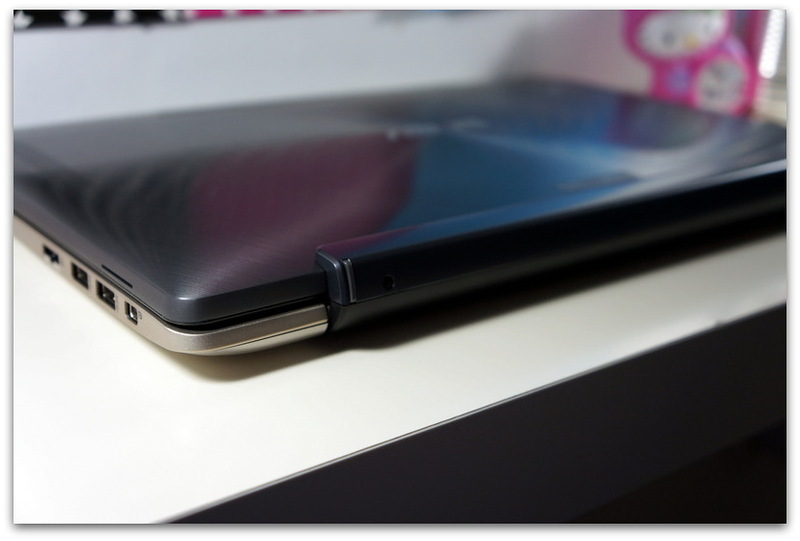
Everything is exactly the same as in the Transformer Pad. In order to remove the tablet, just pull the button-slider on the hinge.
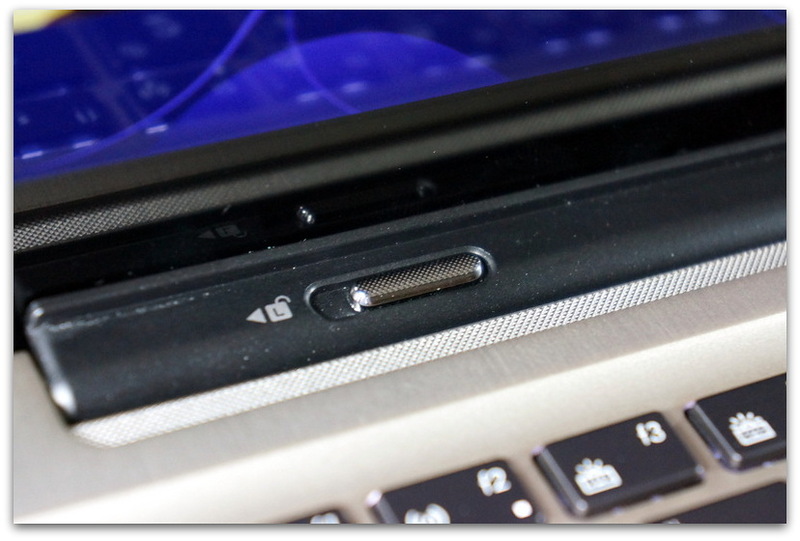
For convenience of perception, I will insert the tablet into the dock and describe all the available interfaces.
On the left side of the tablet is a universal headset jack, next to micro HDMI, then a small perforation made by a laser, from where the diode shines, showing the status of the battery.
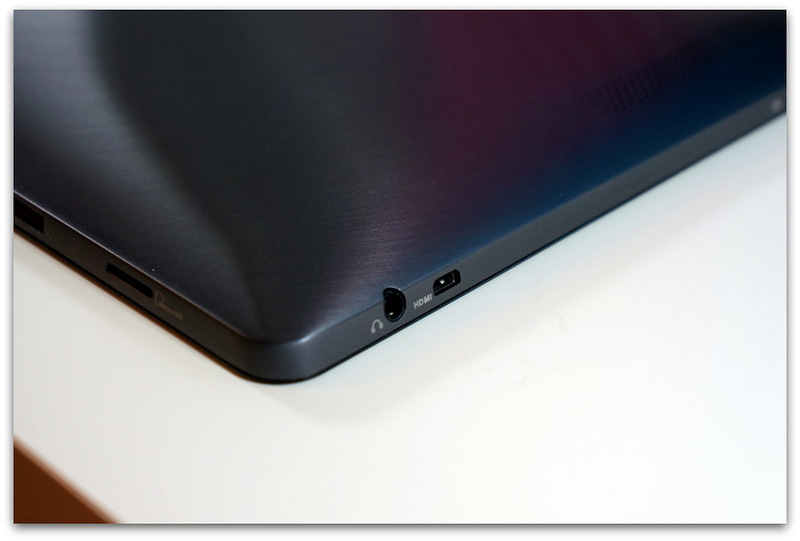
Then we see the hole for hot rebooting the device and the volume rocker.

At the dock there is a magnetic connector of the charger, a card reader that reads all modern cards, punching of the battery indicators and hard disk access.
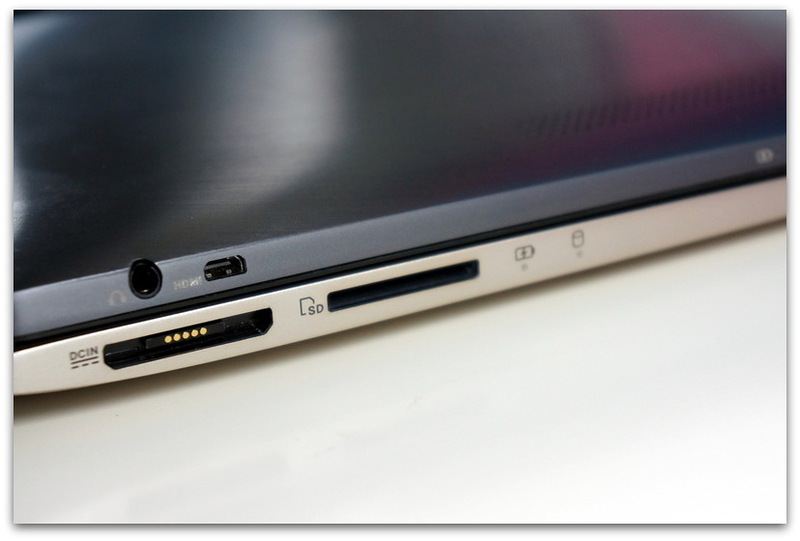
On the opposite side of the dock is a mini DisplayPort monitor output, two USB 3.0 ports and a compact RJ45 for the network.
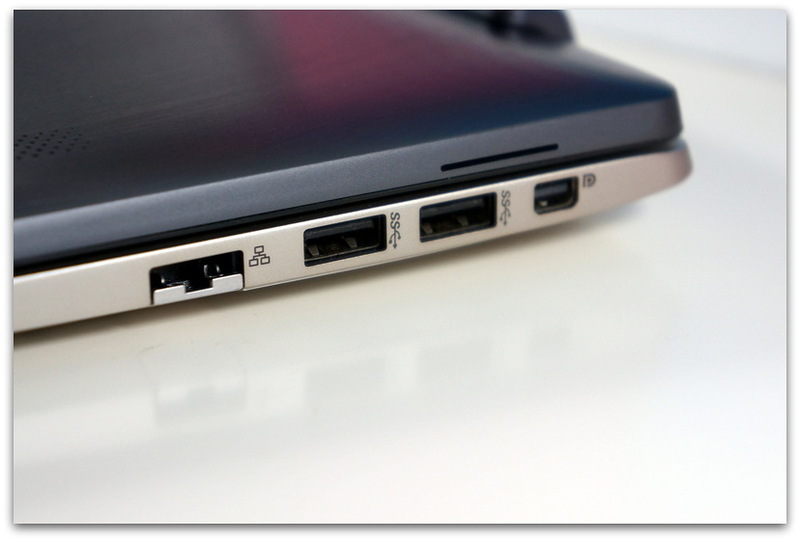
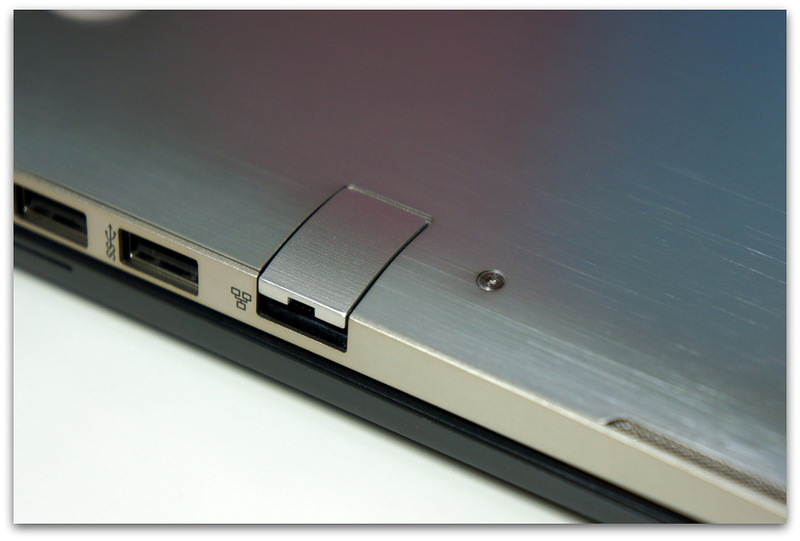
At the bottom of the tablet there is a micro SD card reader that reads cards up to 64 GB. Accordingly, the built-in memory can be increased.
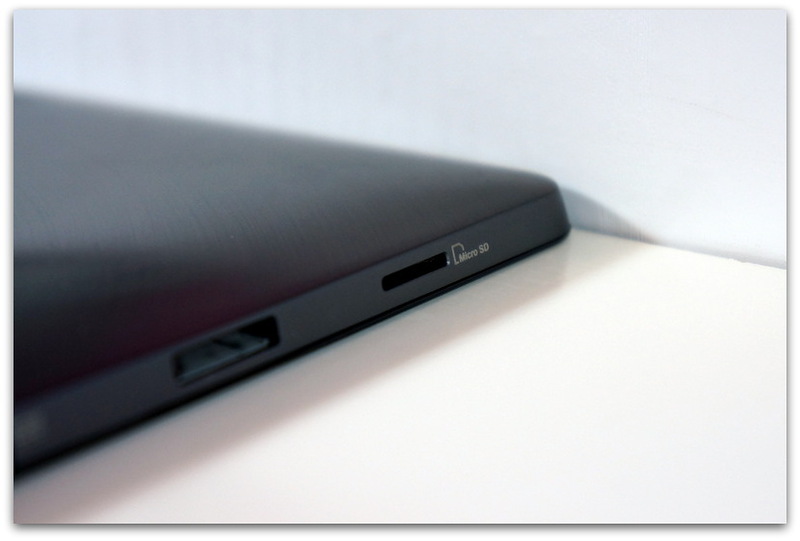
If the tablet is inserted in the docking station, access to the memory card remains free.

Then we see the holes for attaching the docking station, the magnetic connector for the charger and the connector for synchronization with the docking station.
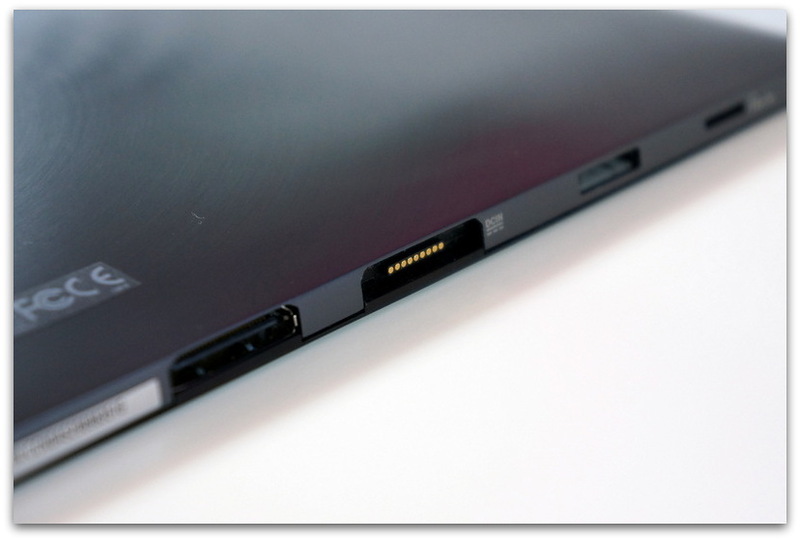
The sound component is certified by Bang & Olufsen - a Danish company specializing in the production of hi-end audio and video equipment. There is also support for technology SonicMaster.
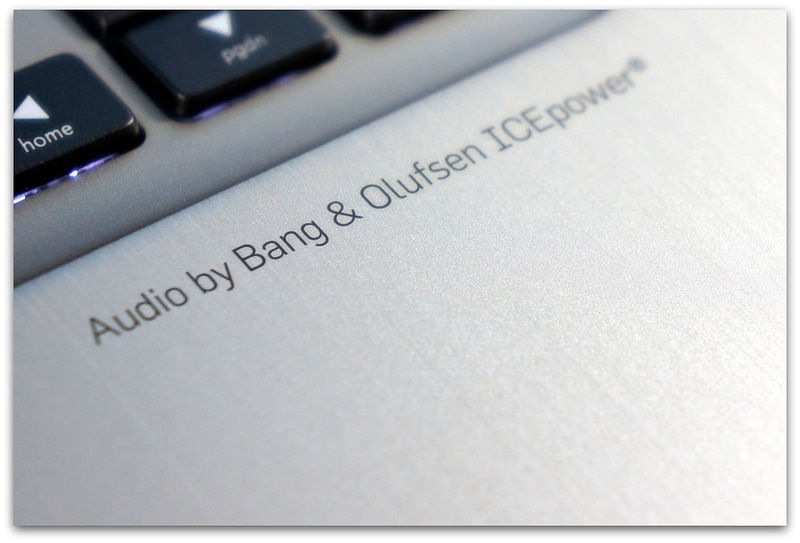
According to engineers at ASUS, this technology involves the use of hardware and software to improve the sound quality, which is close to what a full-fledged separate audio systems provide.
In fact, we already have four high-quality speakers: two - in the tablet itself and two - in the docking station.
Under the speakers there is a perforation just above the middle. That is, holding the tablet in your hands, you do not close the speakers.
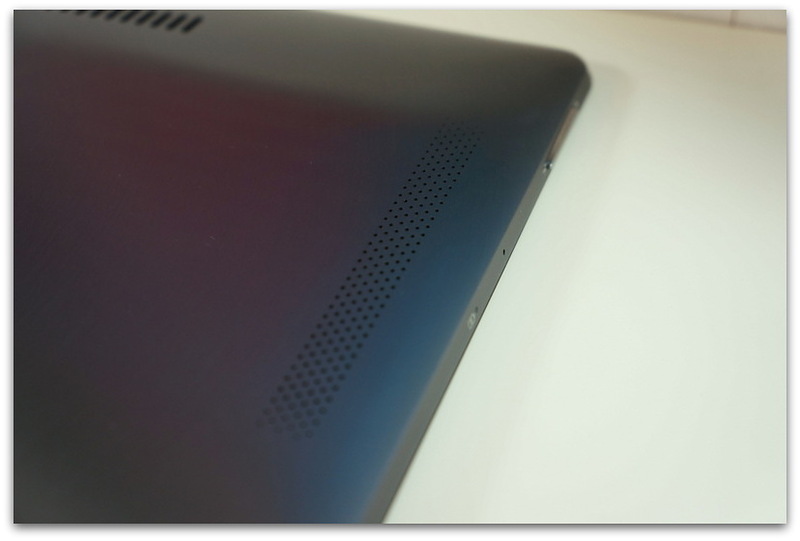
The speakers in the docking station have small slots covered with metal mesh.

The sound is more volume and quality. This is one of the best sound systems I've heard on laptops.
Also, Windows has built-in various sound enhancement software. There are various settings that allow you to select the necessary parameters for user scenarios.

On the top side - two microphones with noise reduction system.
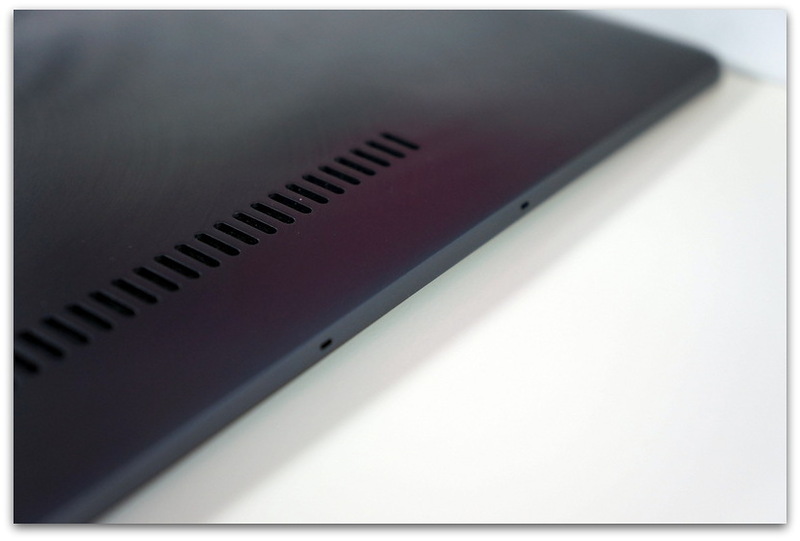
The tablet screen has a resolution of 1920x1080 pixels, a diagonal of 13.3 inches, the number of pixels per inch is 165. The IPS matrix provides wide viewing angles (178o) and perfectly conveys colors. The screen is protected by anti-glare filter.
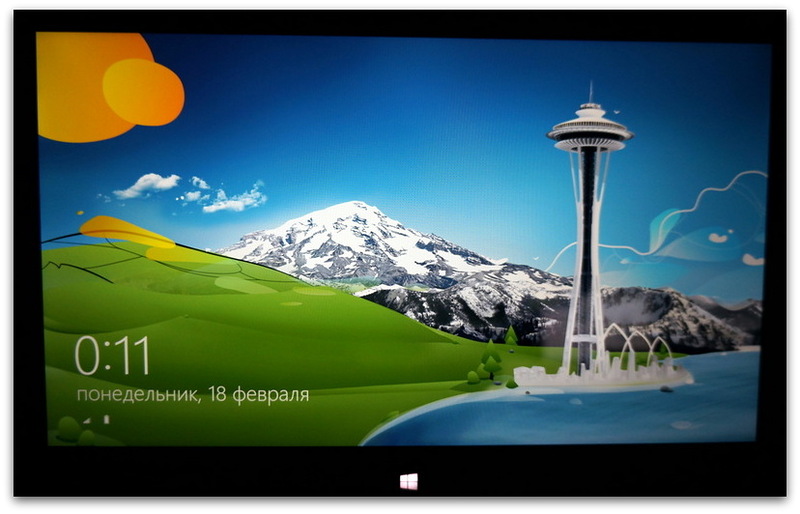
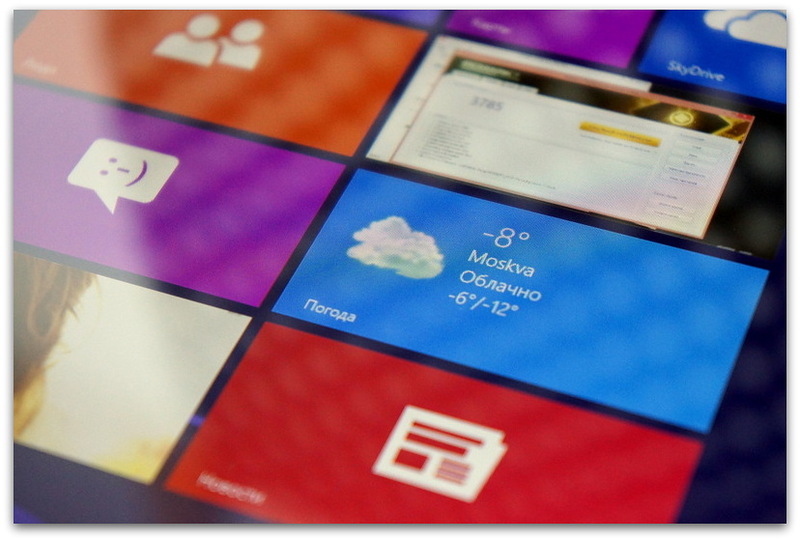
The advantages of the display are surprisingly high contrast (800: 1) and brightness (350 nits). This display is one of the best on the market.
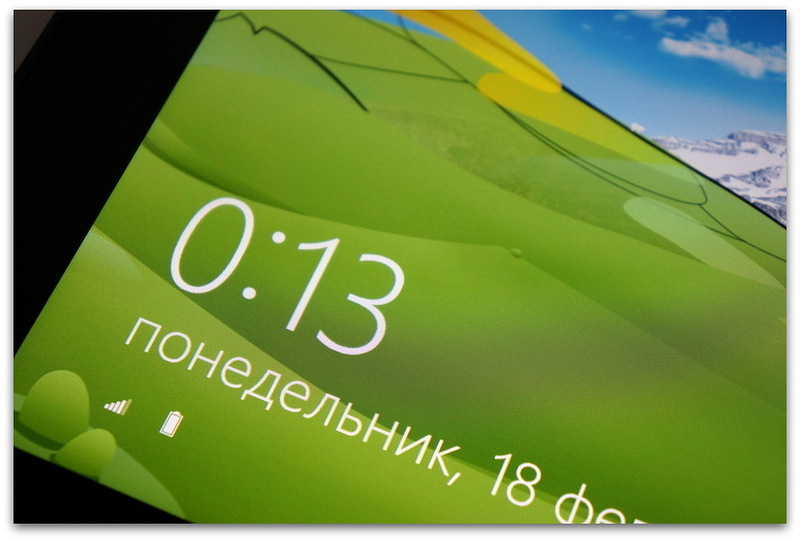
Above the screen is a webcam (720p) for video calls. During her work next to the LED. Also located next to the light sensor to adjust the brightness.
The touch screen is made on capacitive technology with MultiTouch support. The screen works out all 10 fingers. Interesting to play Fruit Ninja.

The glass is protected from scratches by Corning Fit Glass technology. Fingerprints are easily erased due to the oleophobic coating. The sensitivity of the screen is high: even weak touches are worked out. All gestures of Windows 8 are perceived by the system without problems. During operation, the start button under the screen is lit.
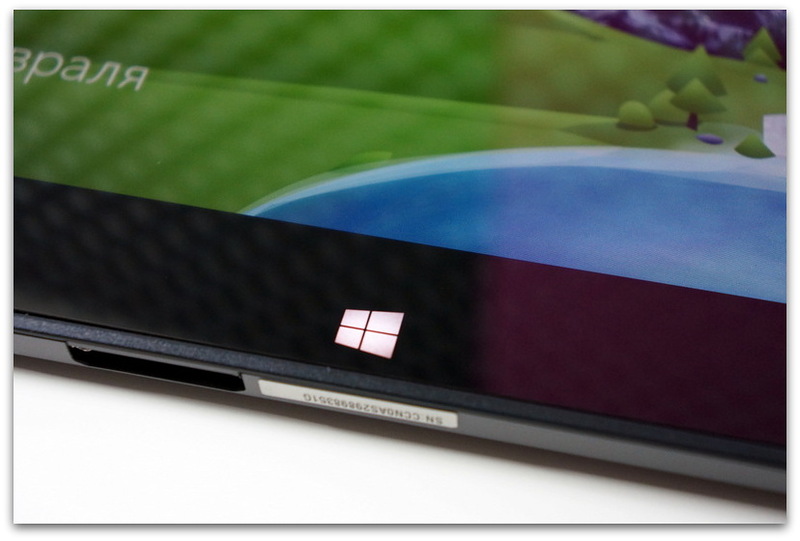
The keyboard on the docking station has a typical arrangement of keys for ultrabooks. The keys are matte, no prints remain. There is nothing to bend here, as the substrate is metal. The keys do not rattle and have a standard course.
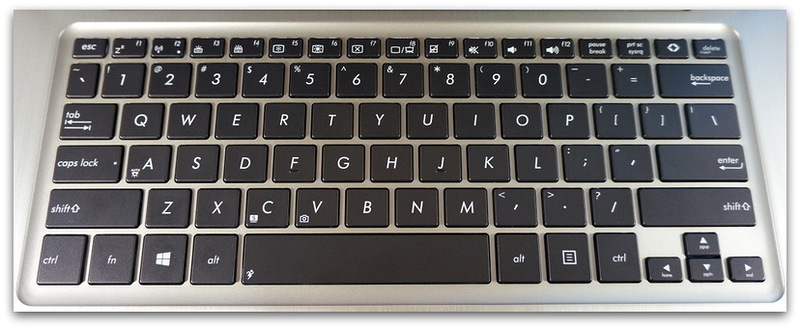
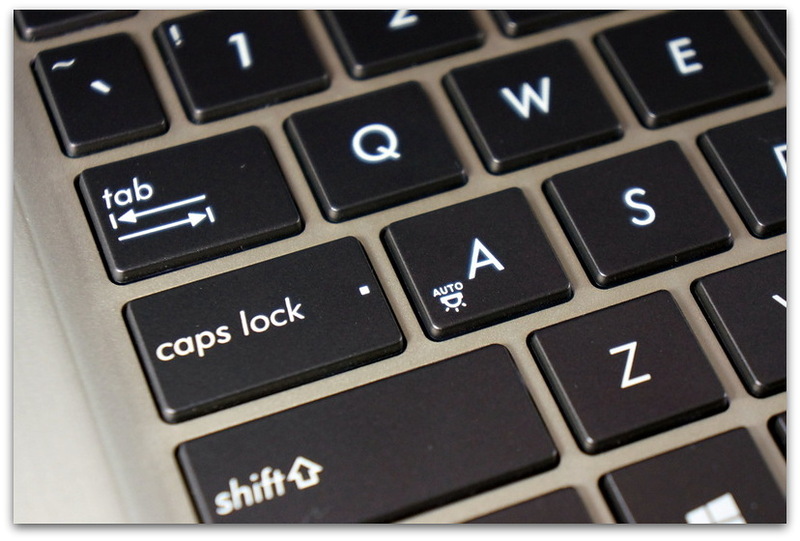
Ctrl in place, next to the Fn button for additional functions. The unspoken standard: if the laptop is thin, then the cursor keys are small.
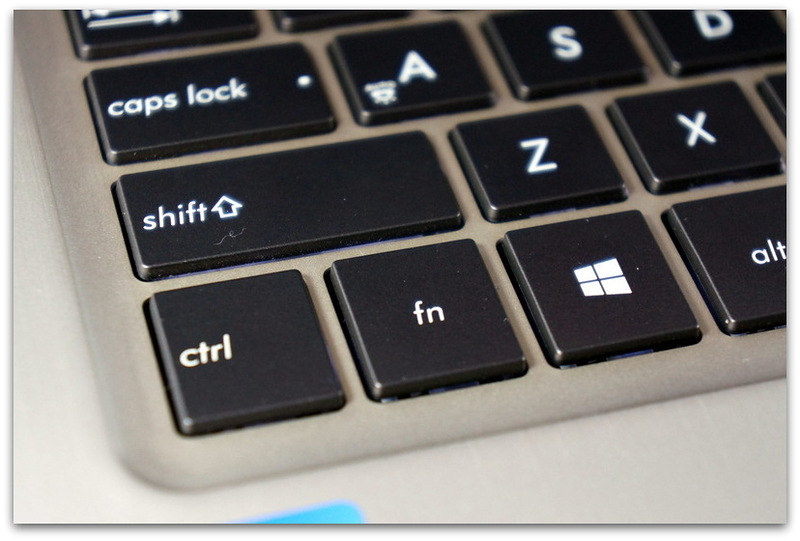
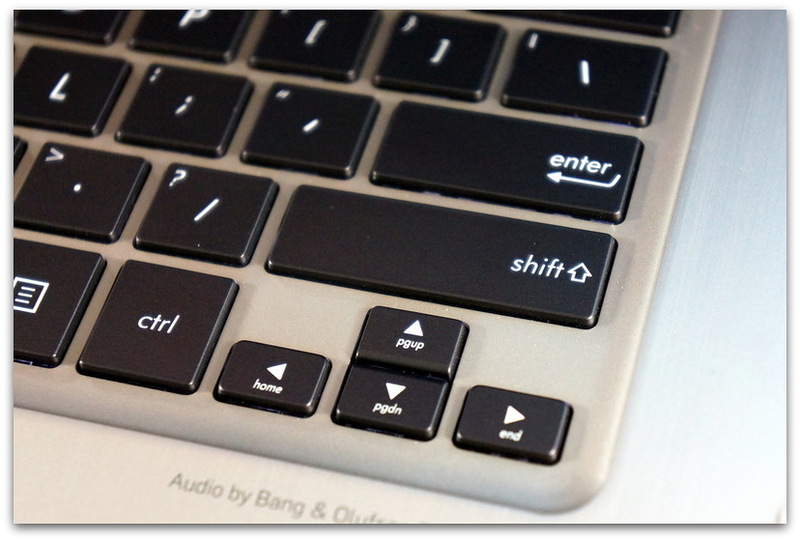
To control the interaction with the docking station there is a special key. When you press it, a window opens in Metro-style, in which you can specify various settings.

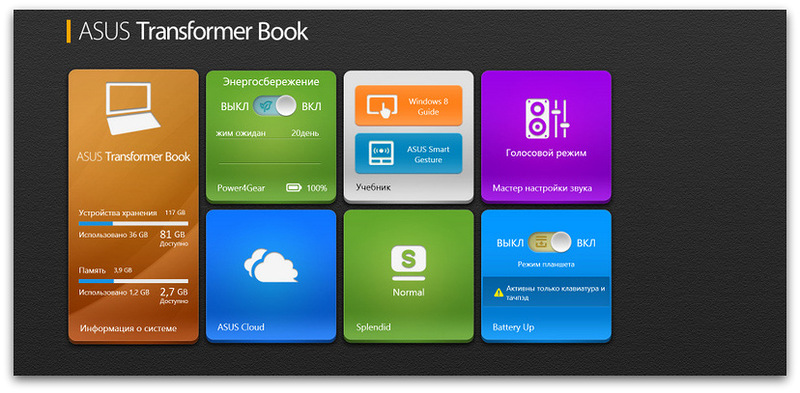
For comfortable work in the dark there is a backlight. The characters on the keys are laser engraved and glow in the dark. The brightness of the backlight (three levels) can be changed by a combination of keys, it can also be adjusted automatically using a light sensor.
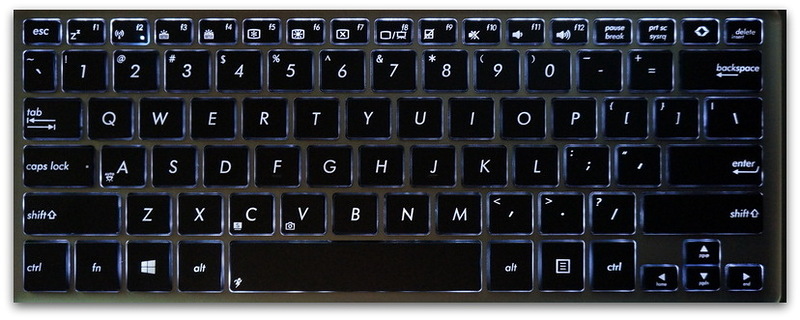
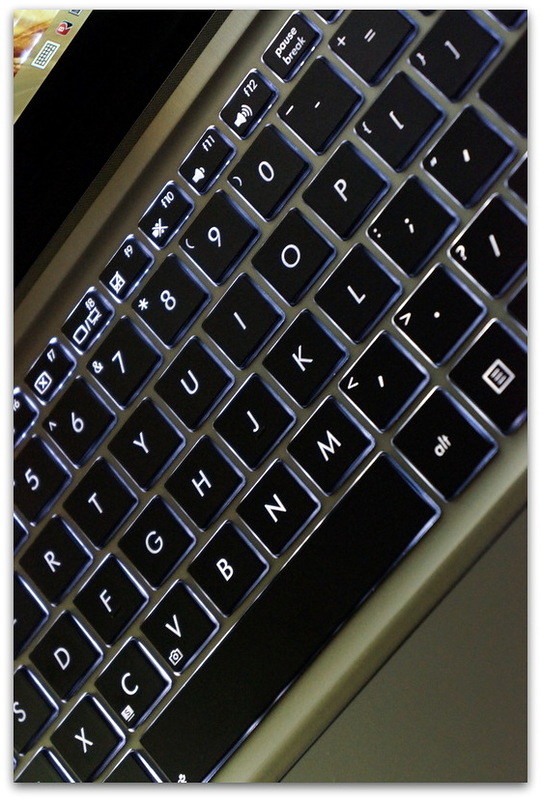
It becomes more and more familiar to see large touchpads in laptops - such trends are only encouraging. The touchpad has a size of 104x61 mm. Finger perfectly slides on a rough texture. You can click the "left mouse button" on the entire area of the touchpad. In the lower right part, you can right-click or tap with two fingers. Naturally, Multi Touch and all Windows 8 gestures are supported: start, application switching, swiping, etc.

It is noticeable that the pad under the touchpad was made a router: the frame turned out to be polished, as if chrome-plated.
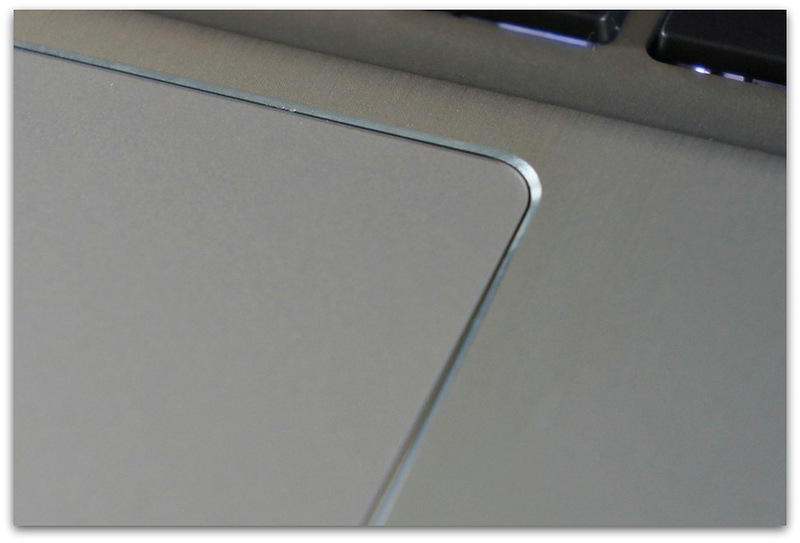
The tablet works quickly: it goes out of sleep mode in 2 seconds, it takes 8 seconds to fully turn on. If a docking station is used, the tablet from sleep mode comes out when the structure is opened. Looks like there is some kind of magnetic sensor.
Inside the Transformer Book there is a small cooler, which sometimes starts to work. It works so quietly that it is usually not heard. Blowing out of the ventilation grille is closer to the power button. If you put the tablet on the table, the grille does not overlap. During productive work, only this place is heated - the rest of the tablet remains cold.
Inside working productive and economical Intel Core i5 3317U Ivy Bridge family, made by 22-nm technology. The usual processor frequency is 1.7 GHz. When you turn on the performance mode, the multiplier increases, and the frequency can increase to 2.6 GHz.
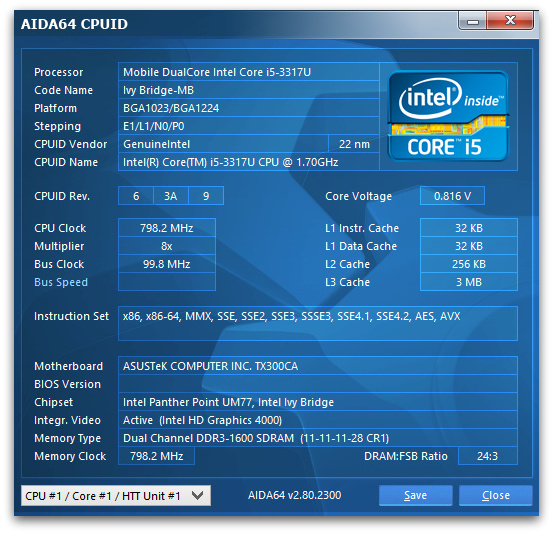

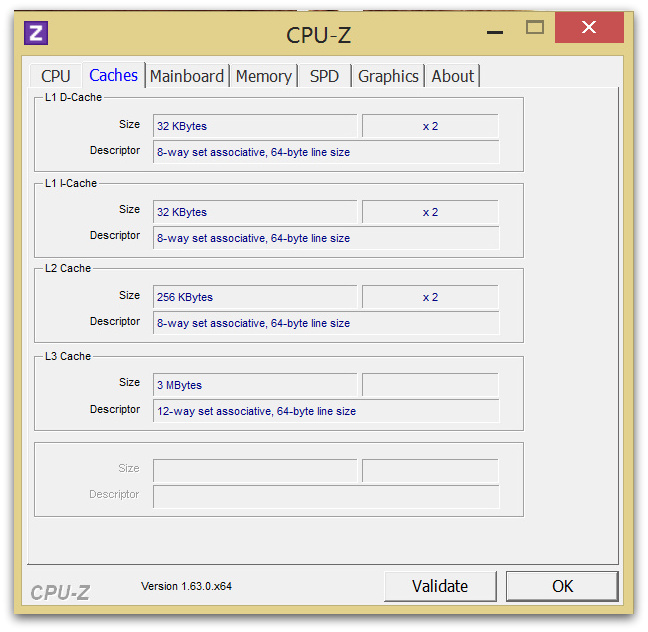
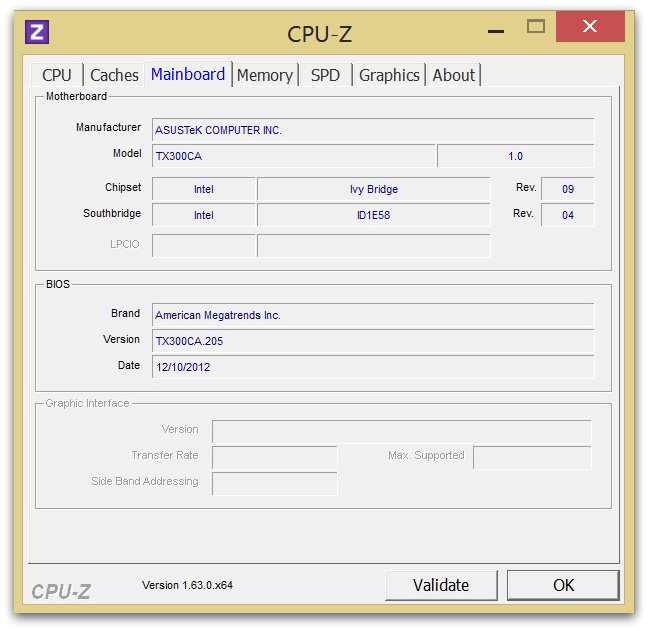
RAM - 4 GB, works in dual channel mode. Expansion is impossible - you will not unstick the display for the sake of it.
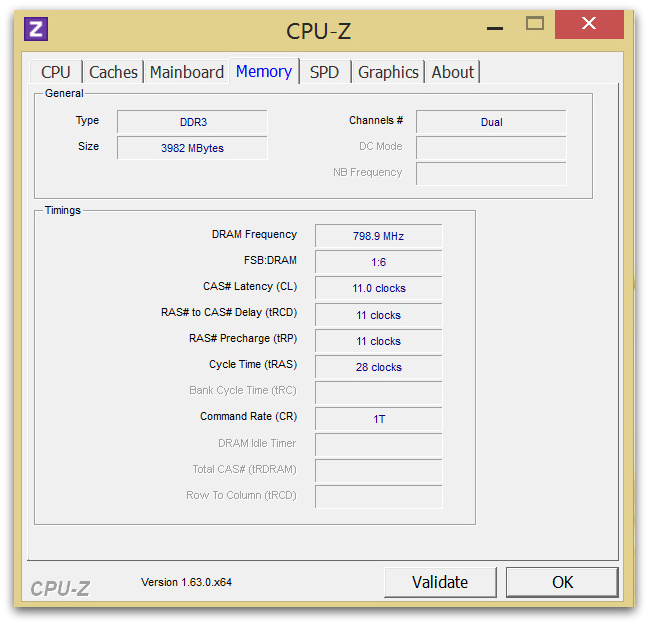
As usual, Intel HD4000 integrated into the processor is responsible for the video. The closest discrete analogs are GeForce 8600 GT and ATI Radeon HD 3670. You can play Batman ArkhamCity (45 FPS on average settings) or Crysis 2 (43 FPS on low settings). Other games can be found here . But in general, of course, this device is not for games.
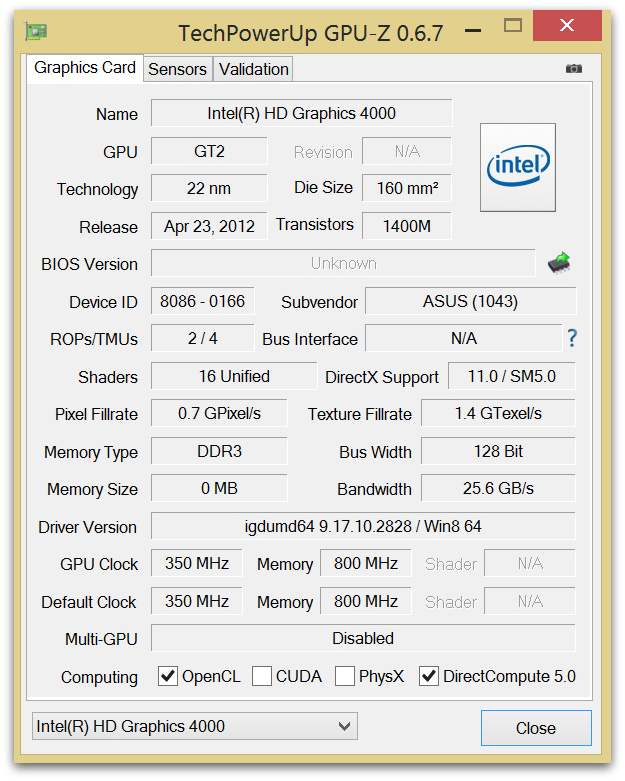
Inside stands the SanDisk SSD U100 at 120 GB.
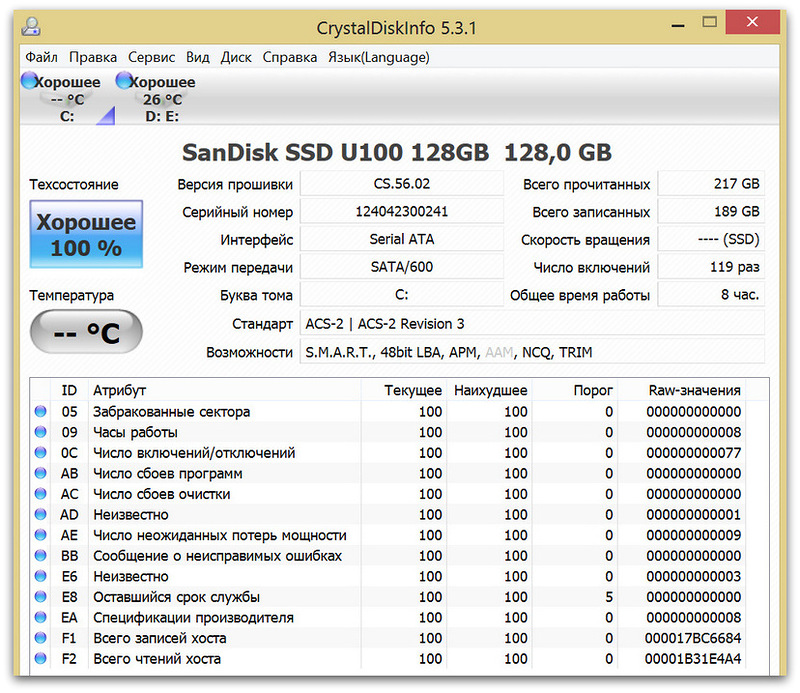
In the docking station - Hitachi HTS 545050a7e380 HDD for 500 GB.

Spherical performance evaluation in a vacuum from Windows.
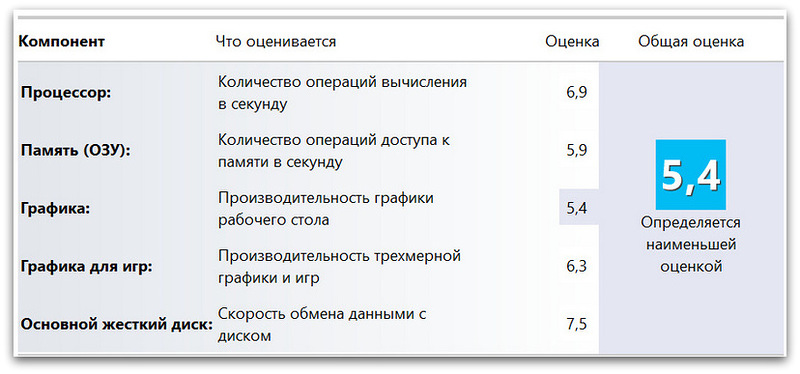
SSD speed tests in CrystalDiskMark and HD Tune Pro.
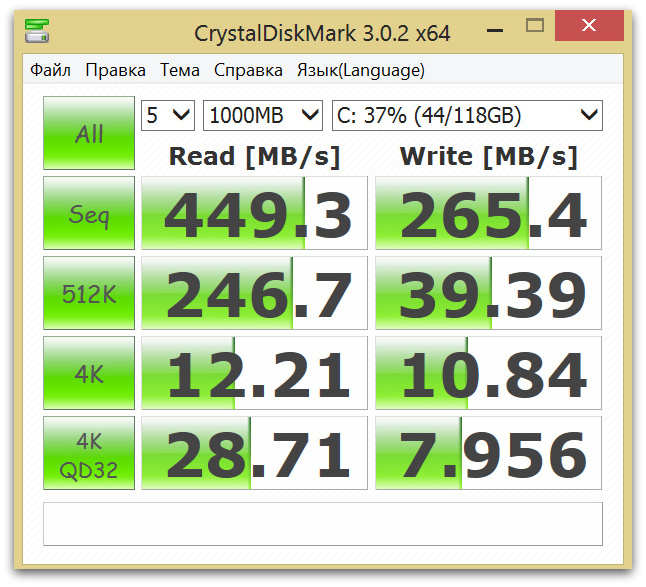
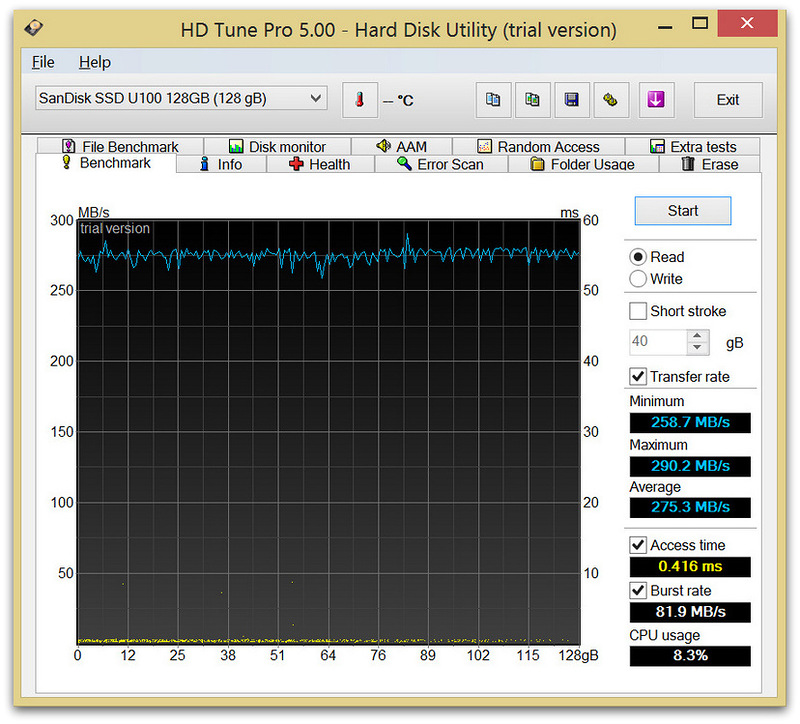
HDD speed tests in CrystalDiskMark and HD Tune Pro.
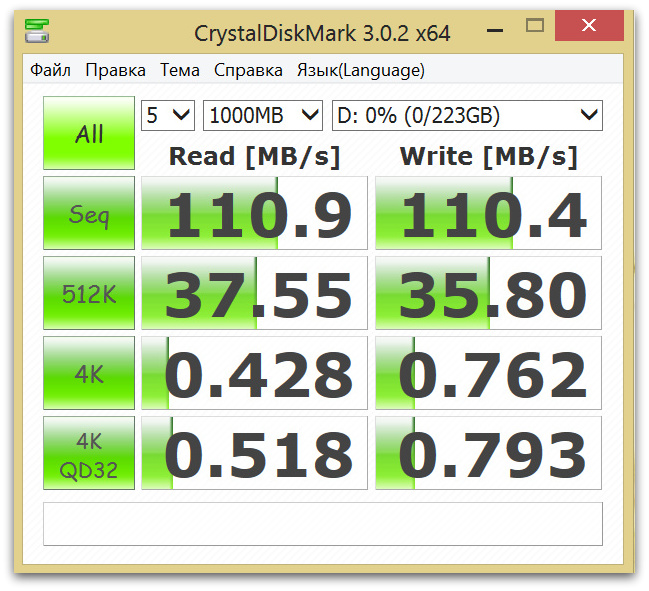
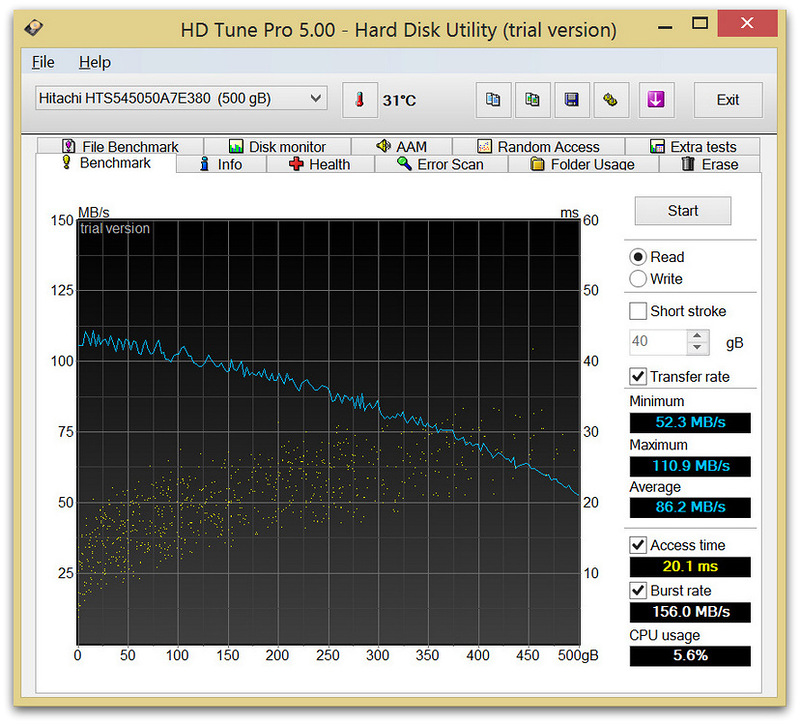
USB 3.0 speed tests in CrystalDiskMark.

3DMark06 and PCMark 7.
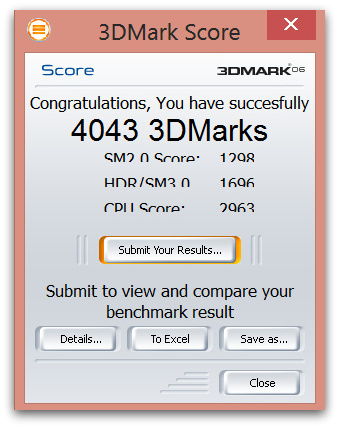

There are two batteries in total. The tablet is a two-cell lithium-polymer battery with a capacity of 5000 mAh, in the docking station - a similar battery of lower capacity (3120 mAh).
Read mode: network off, minimum brightness. 3.5 hours worked external battery, the tablet itself lasted 6.5 hours, a total of 10 hours.
Internet surfing: average brightness, Wi-Fi, every 15 seconds a new page in the browser. 2 hours of battery docking station, 4.5 hours - from the built-in, total 6.5 hours.
Video mode: viewing 1080p video, network off, medium brightness. 2.5 hours from the docking station and 5 hours from the built-in battery. Total 7.5 hours.
In total, it takes 4 hours to charge both batteries. If the tablet is inserted into the dock, the tablet itself first charges, then the docking station. Indicators are for both batteries.
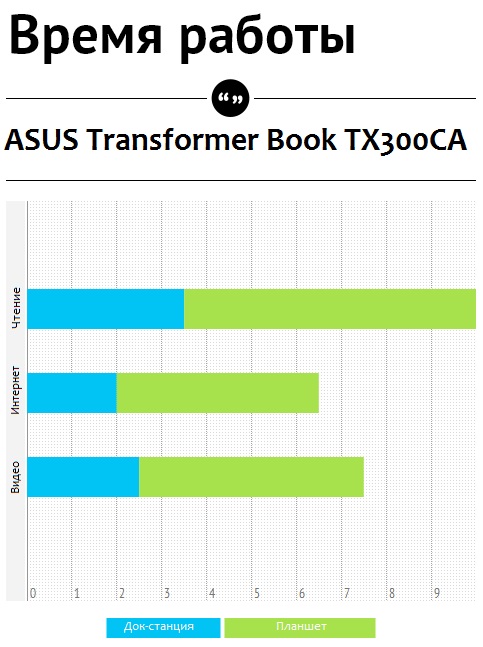
The docking station has two modes of operation.
The first mode: all the ports of the docking station, keyboard, touchpad, hard disk are available to us, but the tablet will not charge from the docking station, only in sleep mode;
The second mode involves the use of an external battery, that is, the tablet is not discharged, the charging of the docking station is wasted, and only after there is no charge left in the docking station will the tablet begin to discharge. In this mode, all interfaces are disabled, the hard disk is not available.
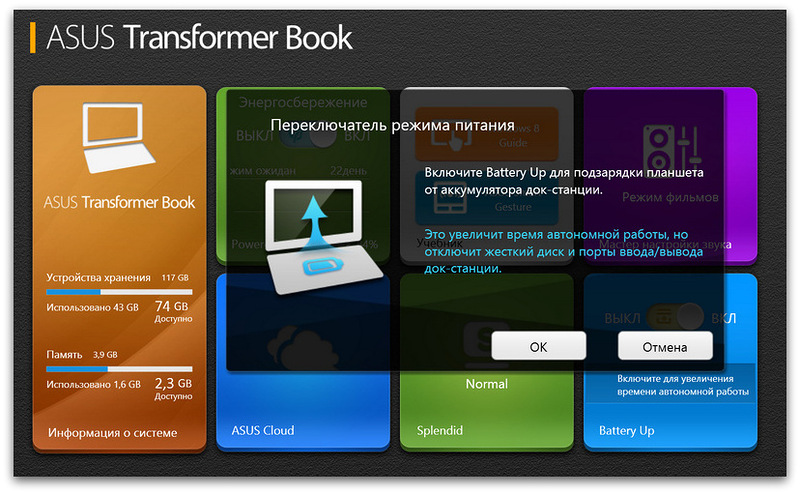
Once again, ASUS was able to create a very unusual and interesting device. Transformer Book is convenient to use as a tablet, and in laptop mode. It turned out a universal device. IPS Full HD screen in conjunction with a productive processor causes a pleasant feeling of using a computer. At first, it’s unusual that a full-fledged computer from the desktop Windows 8 is in the hands. Of course, you won’t work with the tablet for a long time - your hands may get tired, but the very tendency of reducing such devices pleases. An additional battery in the docking station will help out on the trip, and the micro SD slot will increase the built-in memory. In general, if you want an interesting and universal device, then a laptop tablet, then the ASUS Transformer Book would be an excellent choice.
Price from 57 000 p.
Thanks for attention!

')

 Specifications
Specifications
Processor: Intel Core i7 3517U or Intel Core i5 3317U
Operating system: Windows 8
RAM: 4 GB, DDR3 1600 MHz SD RAM, built-in
Display: 13.3 "16: 9 IPSFHD (1920x1080)
Graphics: Embedded, Intel® HD Graphics 4000
Data storage: 320 GB HDD with 128 GB SSD or 500 GB HDD with 128 GB SSD
Camera: HD WebCam
Network: 802.11 b / g / n, Bluetooth 4.0
Tablet interfaces: COMBO audio jack, micro HDMI, Docking Connector, micro SD
Dock Interfaces: 2xUSB 3.0, RJ45 Gigabit-LAN, Docking Connector, mini Display Port, 2-in-1 SD / MMC card reader (SDHC / SDXC)
Sound: 4 speakers, microphone, support for MaxxAudio
Battery: two-cell 5000 and 3120 mAh polymer batteries
Power supply: output - 19 V DC, 3.42A, 65W; input - 100-240 V AC, 50/60 Hz
Dimensions: Tablet: 213 x 340 x 4-11mm; Keyboard: 219 x 340 x 3-12.9mm
Weight: 1.9 kg with docking station


 Package and package
Package and package
The appearance of the box is similar to that of other models of laptops from ASUS - a black elongated box of small length, the surface is matte, the Transformer Book is depicted at the top. Stickers, barcodes are missing - nothing more.

Opening the box, we see: the tablet, on the right - the charger. There is a sponge on the inner surface of the lid of the box to prevent scratches on the device, although initially the tablet itself and the dock are packed in film. Below there is a small notch for more convenient removal of the tablet.

Remove the dividing cardboard and see the bottom of the docking station, under it - an envelope with the documentation.



The charger is different in that it uses not a standard connector, which is inserted into the tablet, but a magnetic one. To connect it, it is enough to bring the connector to the connector on the case, no matter how it is turned. To disconnect the charger, just pull the wire. Everything is simple and quite comfortable. And now, if you accidentally pull the charging cord, the laptop will not fall off the table - just unhook the wire.

The charger itself is small, has a matte body, glossy sides. Charging design repeats the idea of concentric circles on ASUS laptops.

 Appearance
Appearance
The front part is completely covered with glass. The widescreen screen, respectively, the device case turned out to be elongated and narrow. After 9-inch tablets, it is unusual to hold such a big device in your hands. When the tablet is inserted into the dock, it no longer seems so narrow - we have the usual modern laptop. The tablet itself weighs 975 g, its dimensions are 340x219 mm, and its thickness is only 11 mm. Moreover, when you hold it in your hands, it seems even thinner due to the fact that the thickness of the structure around the perimeter is reduced to 4 mm. The body is made of machined metal sheet and covered with a display, there are no bolts.

I checked all the glass around the perimeter - it does not press through, it does not creak. The design is strong and not bent. In the design of the back cover, ASUS follows the concept of ZENBOOK - concentric circles extending from the center.


Upstairs there is a ventilation grille, with large speaker grilles on the sides.

If you like it better when there is nothing extra on the device, you can remove the sticker.

Now consider the docking station into which the tablet itself is inserted. The body is completely made of metal, the device is solid and durable.

In the hands does not bend or creak, the construction is sound. The bottom is covered with a metal sheet, the joints fit exactly, the distance between the body and the bottom is minimal.


The docking station is made in a recognizable wedge-shaped design. The thickness of the dock is about 12 mm, it weighs 956 g. The hinge is made of thick plastic. The pins that hold the device, steel, latches are also metal. In order to avoid scratching the glass during installation in the dock, the fastening walls are covered with a cloth.

The process of installing the tablet in the docking station is quite simple: drop the device into the dock, we hear a click - it's done.

Everything is exactly the same as in the Transformer Pad. In order to remove the tablet, just pull the button-slider on the hinge.

 Interfaces
Interfaces
For convenience of perception, I will insert the tablet into the dock and describe all the available interfaces.
On the left side of the tablet is a universal headset jack, next to micro HDMI, then a small perforation made by a laser, from where the diode shines, showing the status of the battery.

Then we see the hole for hot rebooting the device and the volume rocker.

At the dock there is a magnetic connector of the charger, a card reader that reads all modern cards, punching of the battery indicators and hard disk access.

On the opposite side of the dock is a mini DisplayPort monitor output, two USB 3.0 ports and a compact RJ45 for the network.


At the bottom of the tablet there is a micro SD card reader that reads cards up to 64 GB. Accordingly, the built-in memory can be increased.

If the tablet is inserted in the docking station, access to the memory card remains free.

Then we see the holes for attaching the docking station, the magnetic connector for the charger and the connector for synchronization with the docking station.

 Sound
Sound
The sound component is certified by Bang & Olufsen - a Danish company specializing in the production of hi-end audio and video equipment. There is also support for technology SonicMaster.

According to engineers at ASUS, this technology involves the use of hardware and software to improve the sound quality, which is close to what a full-fledged separate audio systems provide.
In fact, we already have four high-quality speakers: two - in the tablet itself and two - in the docking station.
Under the speakers there is a perforation just above the middle. That is, holding the tablet in your hands, you do not close the speakers.

The speakers in the docking station have small slots covered with metal mesh.

The sound is more volume and quality. This is one of the best sound systems I've heard on laptops.
Also, Windows has built-in various sound enhancement software. There are various settings that allow you to select the necessary parameters for user scenarios.

On the top side - two microphones with noise reduction system.

 Screen and Camera
Screen and Camera
The tablet screen has a resolution of 1920x1080 pixels, a diagonal of 13.3 inches, the number of pixels per inch is 165. The IPS matrix provides wide viewing angles (178o) and perfectly conveys colors. The screen is protected by anti-glare filter.


The advantages of the display are surprisingly high contrast (800: 1) and brightness (350 nits). This display is one of the best on the market.

Above the screen is a webcam (720p) for video calls. During her work next to the LED. Also located next to the light sensor to adjust the brightness.
 Input Devices
Input Devices
The touch screen is made on capacitive technology with MultiTouch support. The screen works out all 10 fingers. Interesting to play Fruit Ninja.

The glass is protected from scratches by Corning Fit Glass technology. Fingerprints are easily erased due to the oleophobic coating. The sensitivity of the screen is high: even weak touches are worked out. All gestures of Windows 8 are perceived by the system without problems. During operation, the start button under the screen is lit.

The keyboard on the docking station has a typical arrangement of keys for ultrabooks. The keys are matte, no prints remain. There is nothing to bend here, as the substrate is metal. The keys do not rattle and have a standard course.


Ctrl in place, next to the Fn button for additional functions. The unspoken standard: if the laptop is thin, then the cursor keys are small.


To control the interaction with the docking station there is a special key. When you press it, a window opens in Metro-style, in which you can specify various settings.


For comfortable work in the dark there is a backlight. The characters on the keys are laser engraved and glow in the dark. The brightness of the backlight (three levels) can be changed by a combination of keys, it can also be adjusted automatically using a light sensor.


It becomes more and more familiar to see large touchpads in laptops - such trends are only encouraging. The touchpad has a size of 104x61 mm. Finger perfectly slides on a rough texture. You can click the "left mouse button" on the entire area of the touchpad. In the lower right part, you can right-click or tap with two fingers. Naturally, Multi Touch and all Windows 8 gestures are supported: start, application switching, swiping, etc.

It is noticeable that the pad under the touchpad was made a router: the frame turned out to be polished, as if chrome-plated.

 Performance
Performance
The tablet works quickly: it goes out of sleep mode in 2 seconds, it takes 8 seconds to fully turn on. If a docking station is used, the tablet from sleep mode comes out when the structure is opened. Looks like there is some kind of magnetic sensor.
Inside the Transformer Book there is a small cooler, which sometimes starts to work. It works so quietly that it is usually not heard. Blowing out of the ventilation grille is closer to the power button. If you put the tablet on the table, the grille does not overlap. During productive work, only this place is heated - the rest of the tablet remains cold.
Inside working productive and economical Intel Core i5 3317U Ivy Bridge family, made by 22-nm technology. The usual processor frequency is 1.7 GHz. When you turn on the performance mode, the multiplier increases, and the frequency can increase to 2.6 GHz.




RAM - 4 GB, works in dual channel mode. Expansion is impossible - you will not unstick the display for the sake of it.

As usual, Intel HD4000 integrated into the processor is responsible for the video. The closest discrete analogs are GeForce 8600 GT and ATI Radeon HD 3670. You can play Batman ArkhamCity (45 FPS on average settings) or Crysis 2 (43 FPS on low settings). Other games can be found here . But in general, of course, this device is not for games.

Inside stands the SanDisk SSD U100 at 120 GB.

In the docking station - Hitachi HTS 545050a7e380 HDD for 500 GB.

Spherical performance evaluation in a vacuum from Windows.

SSD speed tests in CrystalDiskMark and HD Tune Pro.


HDD speed tests in CrystalDiskMark and HD Tune Pro.


USB 3.0 speed tests in CrystalDiskMark.

3DMark06 and PCMark 7.


 Battery and working time
Battery and working time
There are two batteries in total. The tablet is a two-cell lithium-polymer battery with a capacity of 5000 mAh, in the docking station - a similar battery of lower capacity (3120 mAh).
Read mode: network off, minimum brightness. 3.5 hours worked external battery, the tablet itself lasted 6.5 hours, a total of 10 hours.
Internet surfing: average brightness, Wi-Fi, every 15 seconds a new page in the browser. 2 hours of battery docking station, 4.5 hours - from the built-in, total 6.5 hours.
Video mode: viewing 1080p video, network off, medium brightness. 2.5 hours from the docking station and 5 hours from the built-in battery. Total 7.5 hours.
In total, it takes 4 hours to charge both batteries. If the tablet is inserted into the dock, the tablet itself first charges, then the docking station. Indicators are for both batteries.

The docking station has two modes of operation.
The first mode: all the ports of the docking station, keyboard, touchpad, hard disk are available to us, but the tablet will not charge from the docking station, only in sleep mode;
The second mode involves the use of an external battery, that is, the tablet is not discharged, the charging of the docking station is wasted, and only after there is no charge left in the docking station will the tablet begin to discharge. In this mode, all interfaces are disabled, the hard disk is not available.

 Conclusion
Conclusion
Once again, ASUS was able to create a very unusual and interesting device. Transformer Book is convenient to use as a tablet, and in laptop mode. It turned out a universal device. IPS Full HD screen in conjunction with a productive processor causes a pleasant feeling of using a computer. At first, it’s unusual that a full-fledged computer from the desktop Windows 8 is in the hands. Of course, you won’t work with the tablet for a long time - your hands may get tired, but the very tendency of reducing such devices pleases. An additional battery in the docking station will help out on the trip, and the micro SD slot will increase the built-in memory. In general, if you want an interesting and universal device, then a laptop tablet, then the ASUS Transformer Book would be an excellent choice.
Price from 57 000 p.
Thanks for attention!
Source: https://habr.com/ru/post/170861/
All Articles